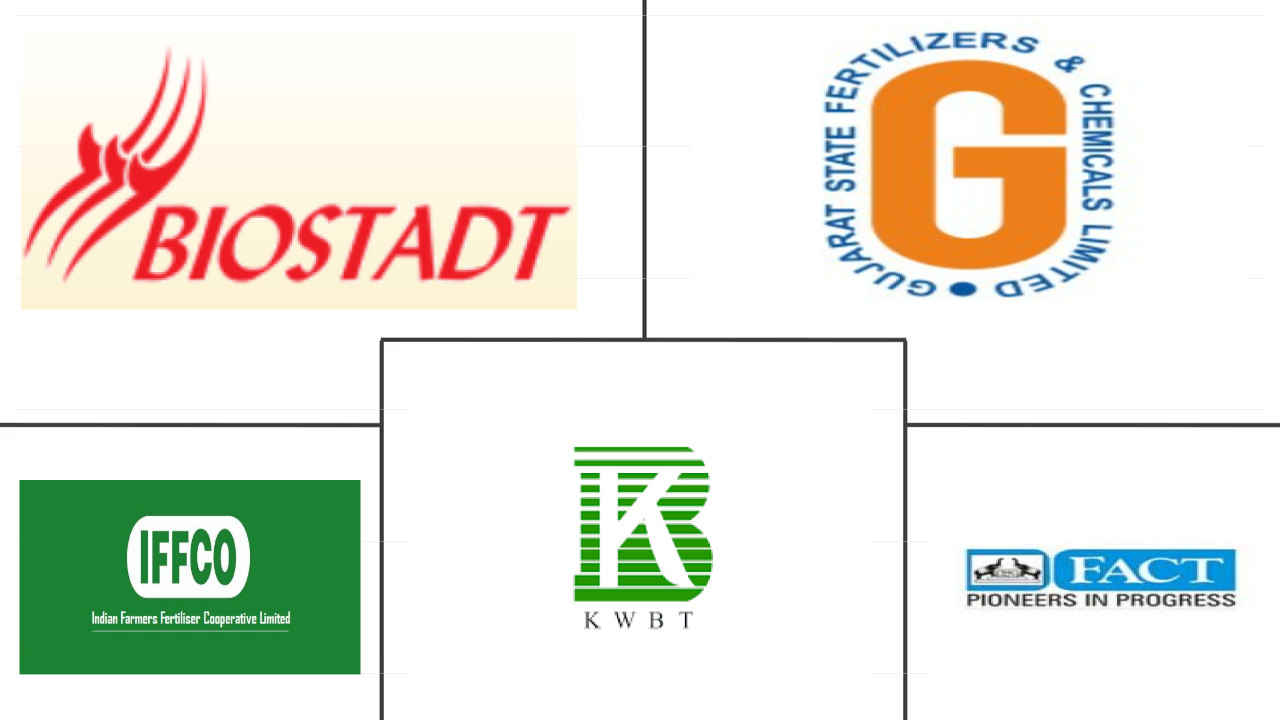Market Size of asia-pacific biofertilizer Industry
|
|
Study Period | 2017 - 2029 |
|
|
Market Size (2024) | USD 552.57 Million |
|
|
Market Size (2029) | USD 900.73 Million |
|
|
Largest Share by Form | Azotobacter |
|
|
CAGR (2024 - 2029) | 10.27 % |
|
|
Largest Share by Country | China |
Major Players |
||

|
||
|
*Disclaimer: Major Players sorted in no particular order |
Asia-Pacific Biofertilizer Market Analysis
The Asia-Pacific Biofertilizer Market size is estimated at 552.57 million USD in 2024, and is expected to reach 900.73 million USD by 2029, growing at a CAGR of 10.27% during the forecast period (2024-2029).
552.57 Million
Market Size in 2024 (USD)
900.73 Million
Market Size in 2029 (USD)
2.61 %
CAGR (2017-2023)
10.27 %
CAGR (2024-2029)
Largest by Form
29.49 %
value share, Azotobacter, 2023
Azotobacter is a non-symbiotic nitrogen-fixing bacteria. It is utilized as a bio-fertilizer for all non-leguminous plants, particularly rice, cotton, and vegetables.
Fastest by Form
11.58 %
Projected CAGR, Rhizobium, 2024-2029
Rhizobium is a soil bacteria that aids leguminous plants in nitrogen fixation, potentially replacing commercial N fertilizers. Rhizobium increases agricultural productivity
Largest by Crop Type
81.95 %
value share, Row Crops, 2023
Rice, wheat, canola, barley, maize, and soybeans are the main row crops grown in the Region. Azotobacter dominated row crops, accounting for 29.2% of the market value in 2022.
Largest by Country
93.40 %
value share, China, 2023
The Azotobacter-based biofertilizers market is dominant in the country, they account for about 31.3% of the market value, which is valued at about USD 137.1 million in 2022
Leading Market Player
14.61 %
market share, Gujarat State Fertilizers & Chemicals Ltd, 2022

The company has a fully equipped R&D center to thrive in the fast-paced industrial developments and to timely innovate and upgrade the products to international standards.
- Biofertilizers are live microorganisms that promote plant nutrition by mobilizing or increasing nutrient availability in soils. Mycorrhiza, Azospirillum, Azotobacter, Rhizobium, and phosphate-solubilizing bacteria are the microorganisms most commonly utilized as biofertilizers in agriculture. The biofertilizer market in the region grew by 4.6% during the historical period between 2017 and 2022. However, the market value of biofertilizers is anticipated to increase by about 77.9% by the end of the forecast period (2023-2029).
- Among these biofertilizers, Azotobacter is the most widely utilized in the Asia Pacific region, accounting for 29.5% of the market in 2022, with a value of USD 138.3 million. Azotobacter is a nitrogen-fixing bacterium that does not require symbiotic relationships to fix atmospheric nitrogen and make it available to plants. It is used as a biofertilizer for all non-leguminous plants, including rice, cotton, and vegetables.
- The consumption of biofertilizers is dominant in row crops, valued at about USD 383.5 million in 2022. The major row crops cultivated in the region include rice, wheat, barley, corn, and soybeans. The dominance of row crops is mainly due to their large organic cultivation area, which accounted for about 67.5% of the region's organic crop cultivation area in 2022.
- Government initiatives in various regional countries to promote organic or sustainable farming have increased in response to growing organic crop production and the rising demand for organic products in both domestic and international markets. These factors may have an impact on the market throughout the forecast period. The value of the Asia-Pacific biofertilizer market is anticipated to increase by about 77.9% by the end of the forecast period, recording a CAGR of 8.6%.
- The organic area under cultivation in Asia-Pacific expanded significantly over the historical period (2017-2022), going from 3.1 million hectares in 2017 to 3.8 million hectares in 2022, owing to the growing demand for organically cultivated food in many Asia-Pacific countries. As a result, the Asia-Pacific biofertilizer market expanded by 4.6% during the historical period.
- The most popular biofertilizer in Asia-Pacific is Azotobacter, which accounted for 29.6% of the market in 2022, valued at USD 134.4 million. It can be used as a biofertilizer in agriculture to make crop production more sustainable through its ability to fix nitrogen and solubilize bacteria.
- Azotobacter as bioinoculants have been demonstrated to increase agricultural productivity by 10-12%, leading to the synthesis of significant amounts of biologically active compounds, including nicotinic acid, biotin, heteroauxins, vitamin B, and gibberellins, which support root development and mineral absorption. The majority of non-leguminous crops, including rice, wheat, millets, cotton, tomato, cabbage, mustard, and safflower, are recommended for Azotobacter use.
- China held 93.5% of the total biofertilizer market value in 2022, making it the dominant country in the region. Row crops dominated the Chinese biofertilizer market in 2022, accounting for 82.3%. Row crops held a major organic acreage in the country, which was 2.1 million hectares in 2022.
- Due to rising consumer interest in organic products, farmers have become more aware of the disadvantages of relying on agricultural chemical inputs and rising organic acreage. The demand for biofertilizers in Asia-Pacific is anticipated to increase throughout the forecast period, with a CAGR of 8.6%.
Asia-Pacific Biofertilizer Industry Segmentation
Azospirillum, Azotobacter, Mycorrhiza, Phosphate Solubilizing Bacteria, Rhizobium are covered as segments by Form. Cash Crops, Horticultural Crops, Row Crops are covered as segments by Crop Type. Australia, China, India, Indonesia, Japan, Philippines, Thailand, Vietnam are covered as segments by Country.
- Biofertilizers are live microorganisms that promote plant nutrition by mobilizing or increasing nutrient availability in soils. Mycorrhiza, Azospirillum, Azotobacter, Rhizobium, and phosphate-solubilizing bacteria are the microorganisms most commonly utilized as biofertilizers in agriculture. The biofertilizer market in the region grew by 4.6% during the historical period between 2017 and 2022. However, the market value of biofertilizers is anticipated to increase by about 77.9% by the end of the forecast period (2023-2029).
- Among these biofertilizers, Azotobacter is the most widely utilized in the Asia Pacific region, accounting for 29.5% of the market in 2022, with a value of USD 138.3 million. Azotobacter is a nitrogen-fixing bacterium that does not require symbiotic relationships to fix atmospheric nitrogen and make it available to plants. It is used as a biofertilizer for all non-leguminous plants, including rice, cotton, and vegetables.
- The consumption of biofertilizers is dominant in row crops, valued at about USD 383.5 million in 2022. The major row crops cultivated in the region include rice, wheat, barley, corn, and soybeans. The dominance of row crops is mainly due to their large organic cultivation area, which accounted for about 67.5% of the region's organic crop cultivation area in 2022.
- Government initiatives in various regional countries to promote organic or sustainable farming have increased in response to growing organic crop production and the rising demand for organic products in both domestic and international markets. These factors may have an impact on the market throughout the forecast period. The value of the Asia-Pacific biofertilizer market is anticipated to increase by about 77.9% by the end of the forecast period, recording a CAGR of 8.6%.
| Form | |
| Azospirillum | |
| Azotobacter | |
| Mycorrhiza | |
| Phosphate Solubilizing Bacteria | |
| Rhizobium | |
| Other Biofertilizers |
| Crop Type | |
| Cash Crops | |
| Horticultural Crops | |
| Row Crops |
| Country | |
| Australia | |
| China | |
| India | |
| Indonesia | |
| Japan | |
| Philippines | |
| Thailand | |
| Vietnam | |
| Rest of Asia-Pacific |
Asia-Pacific Biofertilizer Market Size Summary
The Asia-Pacific biofertilizer market is poised for significant growth, driven by increasing awareness and adoption of sustainable agricultural practices. Biofertilizers, which are live microorganisms that enhance plant nutrition by improving nutrient availability in soils, are gaining traction in the region. Key microorganisms used include Mycorrhiza, Azospirillum, Azotobacter, Rhizobium, and phosphate-solubilizing bacteria. Among these, Azotobacter is particularly popular due to its ability to fix atmospheric nitrogen, making it valuable for non-leguminous crops such as rice, cotton, and vegetables. The market's expansion is supported by government initiatives promoting organic farming and the rising demand for organic products, both domestically and internationally. This trend is further bolstered by the growing organic agricultural land in countries like China, India, Indonesia, and Australia, which are leading the charge in organic crop cultivation.
The market landscape is characterized by a fragmented structure, with major players like Biostadt India Limited, Gujarat State Fertilizers & Chemicals Ltd, and others holding significant shares. The dominance of row crops in the region, particularly in China, underscores the importance of biofertilizers in enhancing crop yields and sustainability. The increasing consumer interest in organic products and the shift away from chemical inputs are driving the demand for biofertilizers. As the region's organic market continues to grow, supported by rising per capita income and consumer awareness, the biofertilizer market is expected to witness robust growth, with a substantial increase in market value anticipated over the forecast period.
Asia-Pacific Biofertilizer Market Size - Table of Contents
-
1. MARKET SEGMENTATION (includes market size in Value in USD and Volume, Forecasts up to 2029 and analysis of growth prospects)
-
1.1 Form
-
1.1.1 Azospirillum
-
1.1.2 Azotobacter
-
1.1.3 Mycorrhiza
-
1.1.4 Phosphate Solubilizing Bacteria
-
1.1.5 Rhizobium
-
1.1.6 Other Biofertilizers
-
-
1.2 Crop Type
-
1.2.1 Cash Crops
-
1.2.2 Horticultural Crops
-
1.2.3 Row Crops
-
-
1.3 Country
-
1.3.1 Australia
-
1.3.2 China
-
1.3.3 India
-
1.3.4 Indonesia
-
1.3.5 Japan
-
1.3.6 Philippines
-
1.3.7 Thailand
-
1.3.8 Vietnam
-
1.3.9 Rest of Asia-Pacific
-
-
Asia-Pacific Biofertilizer Market Size FAQs
How big is the Asia-Pacific Biofertilizer Market?
The Asia-Pacific Biofertilizer Market size is expected to reach USD 552.57 million in 2024 and grow at a CAGR of 10.27% to reach USD 900.73 million by 2029.
What is the current Asia-Pacific Biofertilizer Market size?
In 2024, the Asia-Pacific Biofertilizer Market size is expected to reach USD 552.57 million.

